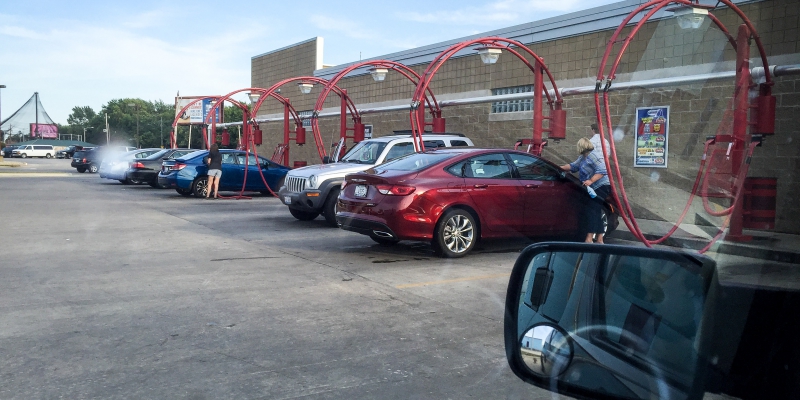Have you ever wondered about what goes on in full service car wash businesses like The Wash Tub? Here’s a closer look at the car wash steps, machinery and supplies that transform your dirty car into a clean one.
The Cleaning Bay
First, your car will be placed on the conveyor track, as guided by a correlator, a series of rollers allowing the wheels of your car to slide sideways. Your car’s engine will be turned off and placed in neutral.
The small rollers on the conveyor track push your car forward so that it rolls along the tunnel. These rollers may either engage the front left wheel (i.e., front wheel pull) or the rear left wheel (i.e., rear wheel push).
Second, your car passes through two infrared sensors (i.e., eyes) so that it interrupts the signal. In turn, the eyes send a signal to a computer’s digital control system (DCS) running the automated car wash. The DCS also determines the vehicle’s length and makes the necessary adjustment to the system.
The next steps in the cleaning process then takes place.
The Initial Cleaning Process
Your car undergoes a pre-soak, usually through an arch where several small nozzles spray a special solution over its exterior. The special solution wets your car and loosens the dirt on its surface; it contains special chemicals for this purpose.
In many car washes, there are also nozzles (i.e., tire applicators) that spray the tires with another specially-formulated solution. Said solution removes brake dust and brightens the appearance of the tires’ black rubber.
Your car passes through a mitter curtain hanging from a frame on top of the tunnel. The mitter curtain is a series of long, soft strips of cloth while the frame moves up and down in a circular pattern; the latter is operated by a motorized shaft. The strips of cloth then rub back and forth on your car’s surface, thus, removing dirt and dust.
Next comes the foam applicator, a toll that applies detergent to your car’s surface. As soon as it comes into contact with the surface, it transforms into a deep-cleaning foam. The foam applicator also has nozzles that can be adjusted depending on the type of car being cleaned.
The changes can be the size of the nozzles’ opening and the angle of spray. The adjustments are necessary to ensure a more thorough cleaning.
The deep-cleaning foam, by the way, can be created in various ways. The most common is mixing a chemical cleaner with air and water, perhaps even with a coloring agent to make it more pleasing and obvious to the eyes.
Read more about the car wash process in part 2 of this series!
